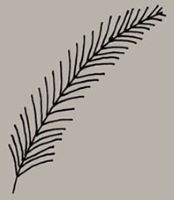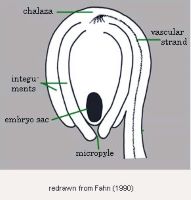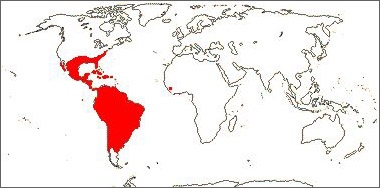Family name: Bromeliaceae Juss.
Synonym(s): Tillandsiaceae Wilbr.
Common name(s): bromeliad family
*Number of genera/species: 51/3,475
List of genera records in GRIN-Global
fruit or seed
Fruit a berryberry:
an indehiscent, fleshy fruit with one or a few to many seeds. The flesh may be homogenous throughout. Or, if the outer part is hard, firm, or leathery, referred to as an hesperidium. Septa are present in some, and the seeds may be arillate or with a fleshy testa. or septicidalsepticidal:
or septicidalsepticidal:
type of capsular dehiscence, opening longitudinally by separating between the septa of adjacent carpels
 capsulecapsule:
capsulecapsule:
a dry, dehiscent fruit derived from a compound ovary , rarely a loculicidalloculicidal:
, rarely a loculicidalloculicidal:
type of capsular dehiscence, opening longitudinally through the locules (compare septicidal)
 capsulecapsule:
capsulecapsule:
a dry, dehiscent fruit derived from a compound ovary , usually simple (multiplemultiple:
, usually simple (multiplemultiple:
fruit formed from several flowers clustered in one mass
fruit, Ananas comosus), 6–80 mm long, globoseglobose:
3D shape—more or less spherical to prismaticprismatic:
to prismaticprismatic:
like a prism; with sharp, definite angles and flat sides
, terete in transection, sometimes stylestyle:
in a flower, the narrow and elongated part of the pistil between the stigma and the ovary; sometimes persisting in fruit persistent, sometimes beaked, with few to many seeds, sepalssepal:
persistent, sometimes beaked, with few to many seeds, sepalssepal:
a member of the outer envelope of a flower (calyx) or pedunclepeduncle:
or pedunclepeduncle:
stalk of an inflorescence
sometimes persistent. Pericarppericarp:
fruit wall or fruit coat
blue, black, purple, white, brown, yellow, fleshy or chartaceouschartaceous:
papery, papyraceous
, sometimes pubescentpubescent:
surface relief—bearing hairs
, smooth, ribbedribbed:
surface relief—wide, prominent, linear ridges that are generally rounded and longitudinally situated on the surface , or wartywarty:
, or wartywarty:
surface relief—distinct, rounded projections that are large relative to the fruit size; tuberculate, verrucose . Mesocarpmesocarp:
. Mesocarpmesocarp:
the middle layer of the pericarp, if divided into layers , if present, fleshy.
, if present, fleshy.
Seeds globoseglobose:
3D shape—more or less spherical to fusiformfusiform:
to fusiformfusiform:
spindle-shaped; broadest at the middle and tapering at both ends , often flattened in transection, 3–6 mm long, sometimes with caudatecaudate:
, often flattened in transection, 3–6 mm long, sometimes with caudatecaudate:
tapering to a long, tail-like appendage or plumoseplumose:
or plumoseplumose:
(of a hair or bristle) feather-like appendages or wings (circumferential or bicaudate). Seed coat black or brown, dulldull:
appendages or wings (circumferential or bicaudate). Seed coat black or brown, dulldull:
reflecting only a low proportion of incident light, with no apparent sheen , smooth or reticulatereticulate:
, smooth or reticulatereticulate:
surface relief—netted, raised walls or concave grooves forming a net-like surface pattern with flat, concave, or convex interspaces , striatestriate:
, striatestriate:
surface relief—having fine, parallel lines, grooves or ridges or wrinkledwrinkled:
or wrinkledwrinkled:
surface relief—shallow, irregular folds and furrows covering the surface; appearing overall though crumpled and then spread out , sometimes pubescentpubescent:
, sometimes pubescentpubescent:
surface relief—bearing hairs
.
Embryo small, well developed, usually cylindriccylindrical:
3D shape—a cylinder, with parallel sides and a circular cross-section; tubular or rod-shaped
, sometimes linearlinear:
(shape) long, narrow, and uniform in width; (of embryo) embryo is straight and much longer than wide , curvedcurved:
, curvedcurved:
(of embryo) linear embryo is curved into an arch or horseshoe with the ends far apart or straight, usually peripheralperipheral:
or straight, usually peripheralperipheral:
(of embryo) embryo is curved around the outer edge of the seed, near the seed coat
, sometimes axileaxile:
on or of the axis
and centric, at the base of the copious endosperm (micropylarmicropyle:
an opening in the integuments of an ovule usually acting as a passage for the pollen tube region).
region).
Endosperm copious, mealy.
Fruit and seed traits by subfamilies
Brocchinioideae: Capsulecapsule:
a dry, dehiscent fruit derived from a compound ovary , septicidalsepticidal:
, septicidalsepticidal:
type of capsular dehiscence, opening longitudinally by separating between the septa of adjacent carpels
 . Seeds bicaudate.
. Seeds bicaudate.
Bromelioideae: Berryberry:
an indehiscent, fleshy fruit with one or a few to many seeds. The flesh may be homogenous throughout. Or, if the outer part is hard, firm, or leathery, referred to as an hesperidium. Septa are present in some, and the seeds may be arillate or with a fleshy testa. , fleshy or dry, indehiscentindehiscent:
, fleshy or dry, indehiscentindehiscent:
not opening on its own, as in a fruit
 . Seeds naked, often with sarcotestasarcotesta:
. Seeds naked, often with sarcotestasarcotesta:
pulpy or fleshy outer layer of the seed coat, simulates aril .
.
Hechtioideae: Capsulecapsule:
a dry, dehiscent fruit derived from a compound ovary , septicidalsepticidal:
, septicidalsepticidal:
type of capsular dehiscence, opening longitudinally by separating between the septa of adjacent carpels
 and loculicidalloculicidal:
and loculicidalloculicidal:
type of capsular dehiscence, opening longitudinally through the locules (compare septicidal)
 . Seeds winged to almost naked, often sculptured.
. Seeds winged to almost naked, often sculptured.
Lindmanioideae: Capsulecapsule:
a dry, dehiscent fruit derived from a compound ovary , septicidalsepticidal:
, septicidalsepticidal:
type of capsular dehiscence, opening longitudinally by separating between the septa of adjacent carpels
 . Seeds bicaudate.
. Seeds bicaudate.
Navioideae: Capsulecapsule:
a dry, dehiscent fruit derived from a compound ovary , septicidalsepticidal:
, septicidalsepticidal:
type of capsular dehiscence, opening longitudinally by separating between the septa of adjacent carpels
 , or septicidalsepticidal:
, or septicidalsepticidal:
type of capsular dehiscence, opening longitudinally by separating between the septa of adjacent carpels
 and loculicidalloculicidal:
and loculicidalloculicidal:
type of capsular dehiscence, opening longitudinally through the locules (compare septicidal)
 (Sequencia serrata). Seeds winged to naked.
(Sequencia serrata). Seeds winged to naked.
Pitcairnioideae: Capsulecapsule:
a dry, dehiscent fruit derived from a compound ovary septicidal, or sometimes septicidalsepticidal:
septicidal, or sometimes septicidalsepticidal:
type of capsular dehiscence, opening longitudinally by separating between the septa of adjacent carpels
 and loculicidalloculicidal:
and loculicidalloculicidal:
type of capsular dehiscence, opening longitudinally through the locules (compare septicidal)
 (Dyckia). Seeds small, winged, bicaudate in Fosterella and some Pitcairnia, naked in Navia and Pepinia.
(Dyckia). Seeds small, winged, bicaudate in Fosterella and some Pitcairnia, naked in Navia and Pepinia.
Puyoideae: Capsulecapsule:
a dry, dehiscent fruit derived from a compound ovary , loculicidalloculicidal:
, loculicidalloculicidal:
type of capsular dehiscence, opening longitudinally through the locules (compare septicidal)
 and generally tardily septicidalsepticidal:
and generally tardily septicidalsepticidal:
type of capsular dehiscence, opening longitudinally by separating between the septa of adjacent carpels
 as well. Seeds circumferentially winged.
as well. Seeds circumferentially winged.
Tillandsioideae: Capsulecapsule:
a dry, dehiscent fruit derived from a compound ovary , septicidalsepticidal:
, septicidalsepticidal:
type of capsular dehiscence, opening longitudinally by separating between the septa of adjacent carpels
 . Seeds plumose-appendaged, base or apexapex:
. Seeds plumose-appendaged, base or apexapex:
the point farthest from the point of attachment, or the "tip" of an organ or both.
or both.
| Fruit | |
| Type | berryberry: an indehiscent, fleshy fruit with one or a few to many seeds. The flesh may be homogenous throughout. Or, if the outer part is hard, firm, or leathery, referred to as an hesperidium. Septa are present in some, and the seeds may be arillate or with a fleshy testa.  , septicidalsepticidal: , septicidalsepticidal:type of capsular dehiscence, opening longitudinally by separating between the septa of adjacent carpels  or rarely a loculicidalloculicidal: or rarely a loculicidalloculicidal:type of capsular dehiscence, opening longitudinally through the locules (compare septicidal)  capsulecapsule: capsulecapsule:a dry, dehiscent fruit derived from a compound ovary  |
| Size range | 6–80 mm long |
| Shape(s) | ovoidovoid: 3D shape—ovate  , globoseglobose: , globoseglobose:3D shape—more or less spherical  , trigonoustrigonous: , trigonoustrigonous:3D shape—having three faces that meet at distinct angles; triangular in outline , ellipsoidellipsoid: 3D shape—elliptic , cylindricalcylindrical: 3D shape—a cylinder, with parallel sides and a circular cross-section; tubular or rod-shaped , oblongoblong: 2D shape—much longer than broad with nearly parallel sides, corners are rounded  , conicalconical: , conicalconical:3D shape—cone-shaped, with the point of attachment at the broad end  , cuneiformcuneiform: , cuneiformcuneiform:wedge-shaped , prismaticprismatic: like a prism; with sharp, definite angles and flat sides , fusiformfusiform: spindle-shaped; broadest at the middle and tapering at both ends  |
| Texture | fleshy, chartaceouschartaceous: papery, papyraceous |
| Surface relief | smooth or ribbedribbed: surface relief—wide, prominent, linear ridges that are generally rounded and longitudinally situated on the surface  , wartywarty: , wartywarty:surface relief—distinct, rounded projections that are large relative to the fruit size; tuberculate, verrucose  |
| Color(s) | blue, black, purple, white, brown, yellow |
| Unique features | Septicial capsulescapsule: a dry, dehiscent fruit derived from a compound ovary  often with winged or plumoseplumose: often with winged or plumoseplumose:(of a hair or bristle) feather-like  seeds. seeds. |
| Seed | |
| Size range | 3–6 mm long |
| Shape(s) | linearlinear: (shape) long, narrow, and uniform in width; (of embryo) embryo is straight and much longer than wide  , oblongoblong: , oblongoblong:2D shape—much longer than broad with nearly parallel sides, corners are rounded  , globoseglobose: , globoseglobose:3D shape—more or less spherical  , ovoidovoid: , ovoidovoid:3D shape—ovate  , fusiformfusiform: , fusiformfusiform:spindle-shaped; broadest at the middle and tapering at both ends  , ellipsoidellipsoid: , ellipsoidellipsoid:3D shape—elliptic , cuneiformcuneiform: wedge-shaped , cylindricalcylindrical: 3D shape—a cylinder, with parallel sides and a circular cross-section; tubular or rod-shaped |
| Surface relief | smooth, reticulatereticulate: surface relief—netted, raised walls or concave grooves forming a net-like surface pattern with flat, concave, or convex interspaces  , striatestriate: , striatestriate:surface relief—having fine, parallel lines, grooves or ridges  , wrinkledwrinkled: , wrinkledwrinkled:surface relief—shallow, irregular folds and furrows covering the surface; appearing overall though crumpled and then spread out  |
| Color(s) | black, brown |
| Unique features | Seeds in some genera with caudatecaudate: tapering to a long, tail-like appendage  or plumoseplumose: or plumoseplumose:(of a hair or bristle) feather-like  appendages. appendages. |
| Other | |
| Embryo | small, well developed, usually cylindriccylindrical: 3D shape—a cylinder, with parallel sides and a circular cross-section; tubular or rod-shaped , sometimes linearlinear: (shape) long, narrow, and uniform in width; (of embryo) embryo is straight and much longer than wide  , curvedcurved: , curvedcurved:(of embryo) linear embryo is curved into an arch or horseshoe with the ends far apart  or straight, usually peripheralperipheral: or straight, usually peripheralperipheral:(of embryo) embryo is curved around the outer edge of the seed, near the seed coat and at the base of the copious endosperm (micropylarmicropyle: an opening in the integuments of an ovule usually acting as a passage for the pollen tube  region) region) |
| Nutritive tissue | endosperm copious and mealymealy: loose, dry, and disintegrating in finely granular pieces like meal or flour |
Chiefly tropical, occasionally subtropical, regions of America, one species in tropical West Africa.

Distribution map courtesy of Angiosperm Phylogeny Website.
Baskin and Baskin 2021Baskin and Baskin 2021:
Baskin C and Baskin J. 2021. Relationship of the lateral embryo (in grasses) to other monocot embryos: A status up-grade. Seed Science Research 31 (3): 199-210. doi:10.1017/S0960258521000209; Baker 1889Baker 1889:
Baker JG. 1889. Handbook of the Bromeliaceae. G. Bell amp; Sons, London UK. 243 pp. https://doi.org/10.5962/bhl.title.51681; Benzing 2000Benzing 2000:
Benzing DH. 2000. Bromeliaceae: Profile on Adaptive Radiation. Cambridge University Press, Cambridge UK. 655 pp. https://doi.org/10.1017/CBO9780511565175; Cronquist 1981Cronquist 1981:
Cronquist A. 1981. An integrated system of classification of flowering plants. Columbia University Press, New York. 1261 pp.; Dahlgren et al. 1985Dahlgren et al. 1985:
Dahlgren RMT, Clifford HT, and Yeo PF. 1985. The families of the monocotyledons: structure, evolution, and taxonomy. Springer-Verlag, Berlin. 520 pp.; Kirkbride et al. 2006Kirkbride et al. 2006:
Kirkbride JH, Jr, Gunn CR, and Dallwitz MJ. 2006. Family guide for fruits and seeds, vers. 1.0. Accessed September 2020-January 2022. URL: https://nt.ars-grin.gov/seedsfruits/keys/frsdfam/index.cfm .; Kubitzki et al. 1990+Kubitzki et al. 1990+:
Kubitzki K et al., eds. 1990+. The families and genera of vascular plants. 7+ vols. Berlin etc.; Smith 1957Smith 1957:
Smith LB. 1957. The Bromeliaceae of Colombia. Contributions from the United States National Herbarium 33: 1-303.; Stevenson and Loconte 1995Stevenson and Loconte 1995:
Stevenson DW and Loconte H. 1995. A cladistic analysis of monocot families. In: Rudall PJ, Cribb PJ, Cutler DF, and Humphries CJ, eds. Monocotyledons: Systematics and Evolution. Royal Botanic Gardens, Kew.; Watson and Dallwitz 1992+Watson and Dallwitz 1992+:
Watson L and Dallwitz MJ. 1992+. The families of flowering plants: descriptions, illustrations, identification, and information retrieval. Version: 6th Accessed September 2020-September 2022. URL: delta-intkey.com
*The number of genera and species is based on Christenhusz and Byng 2016Christenhusz and Byng 2016:
Christenhusz MJM and Byng JW. 2016. The number of known plant species in the world and its annual increase. Phytotaxa 261 (3): 201-217. https://doi.org/10.11646/phytotaxa.261.3.1, which may differ from the number of genera in GRIN-Global.